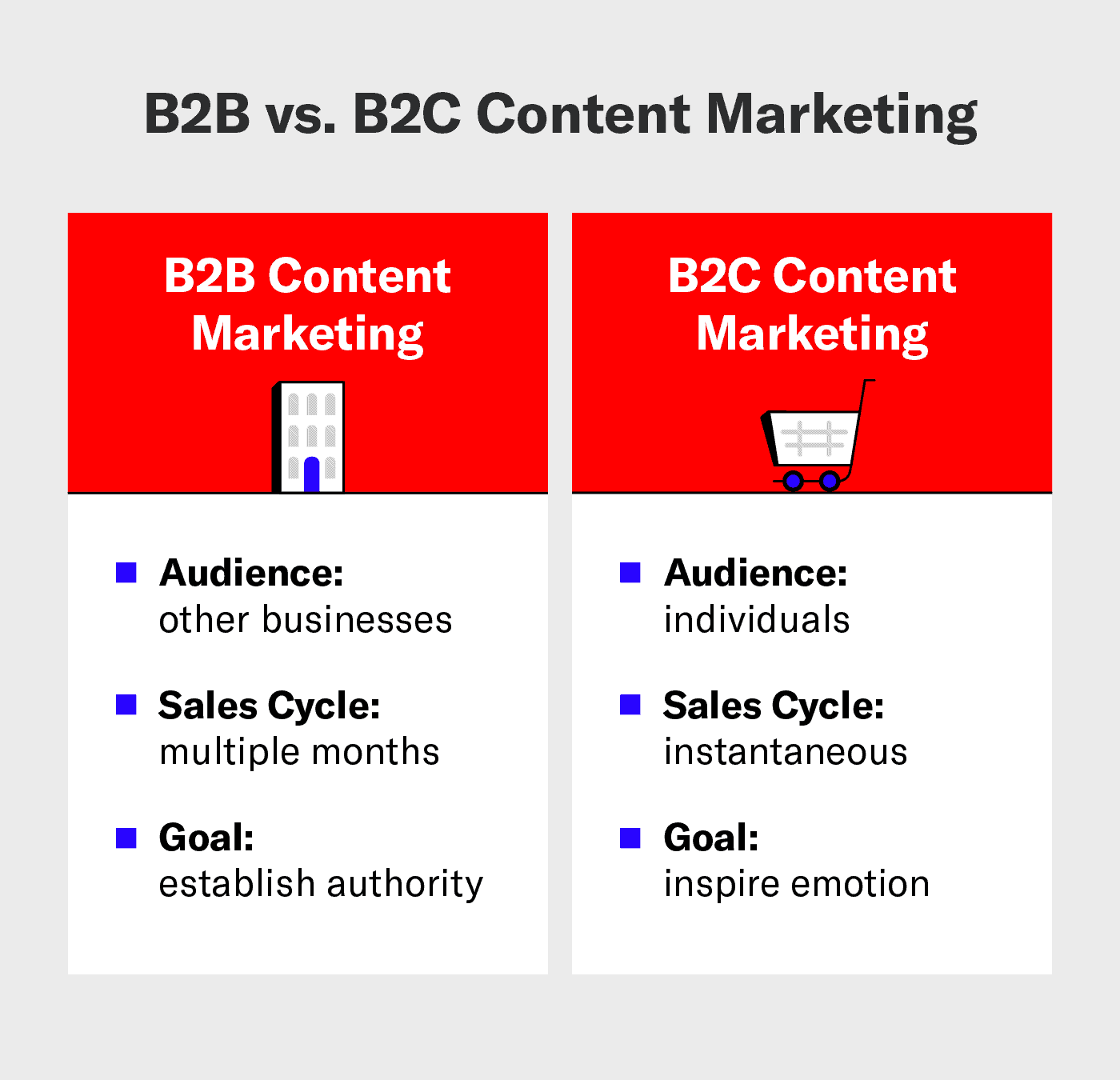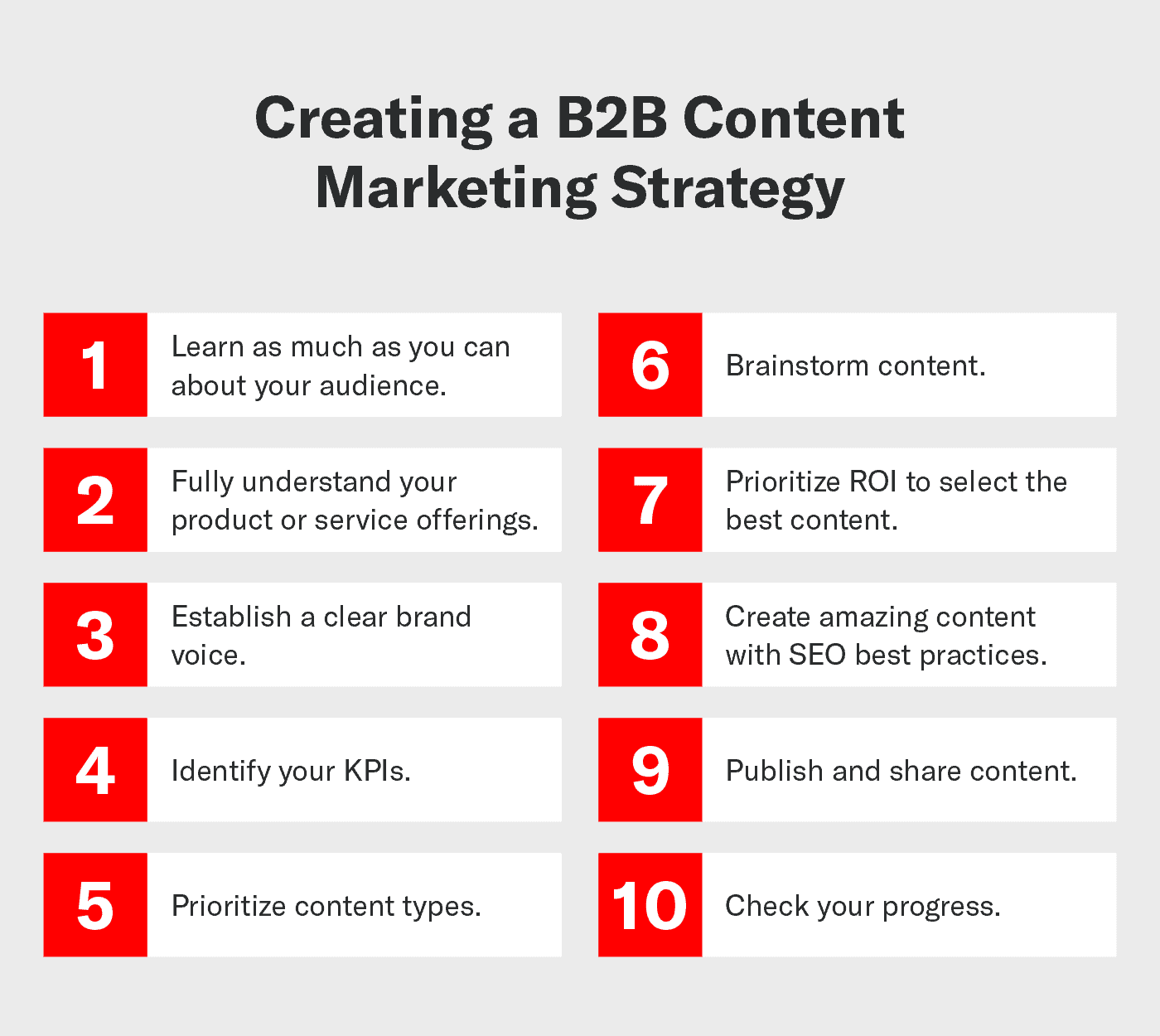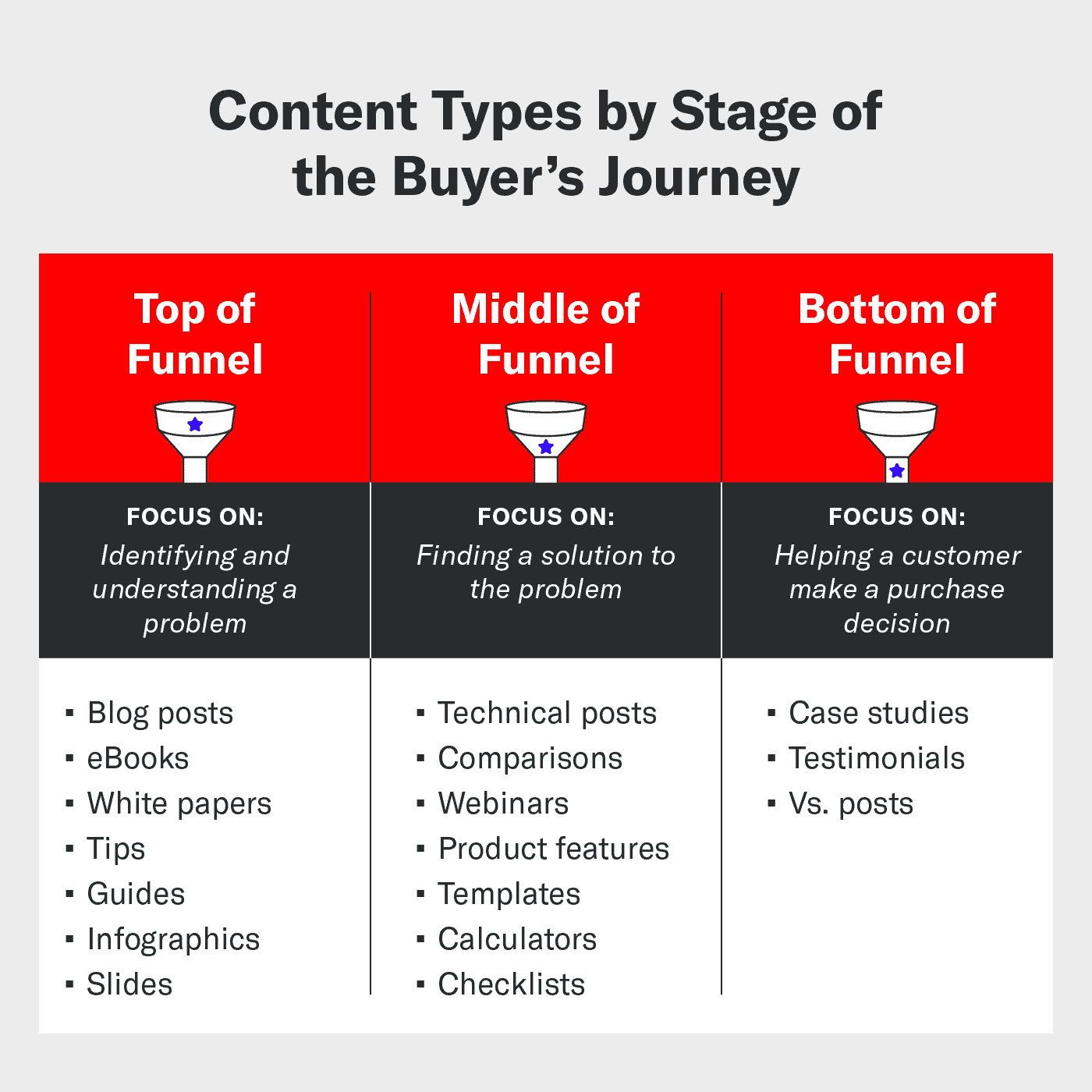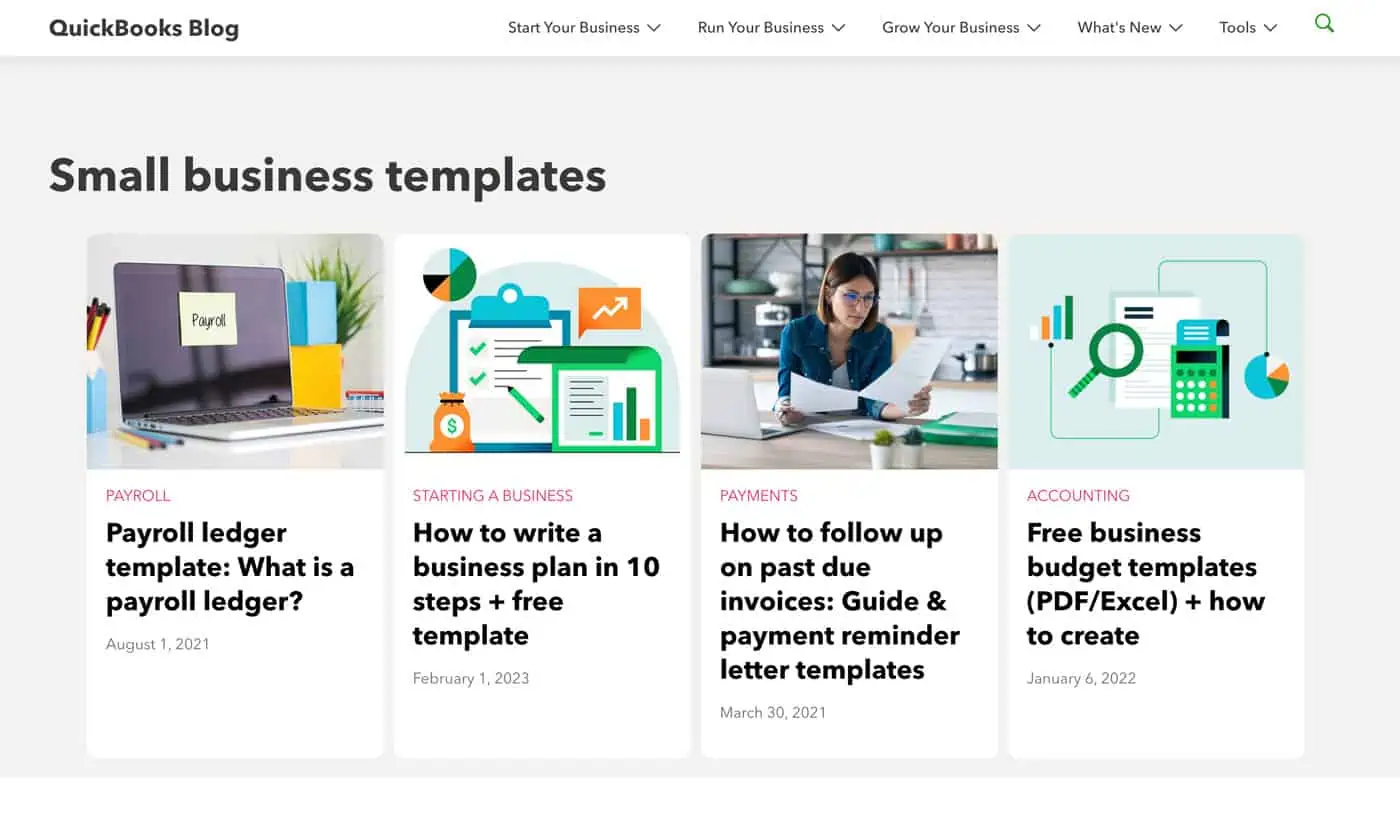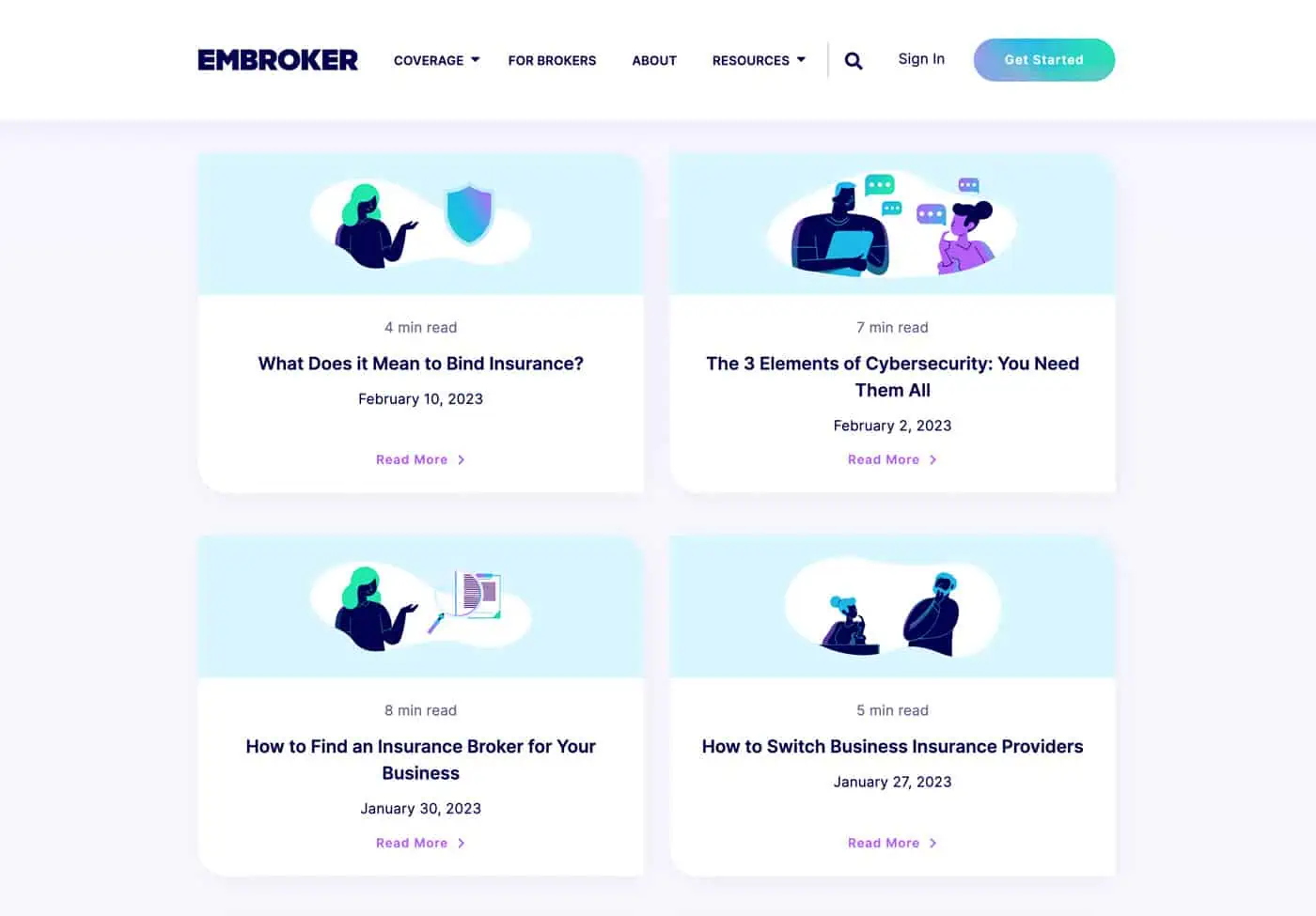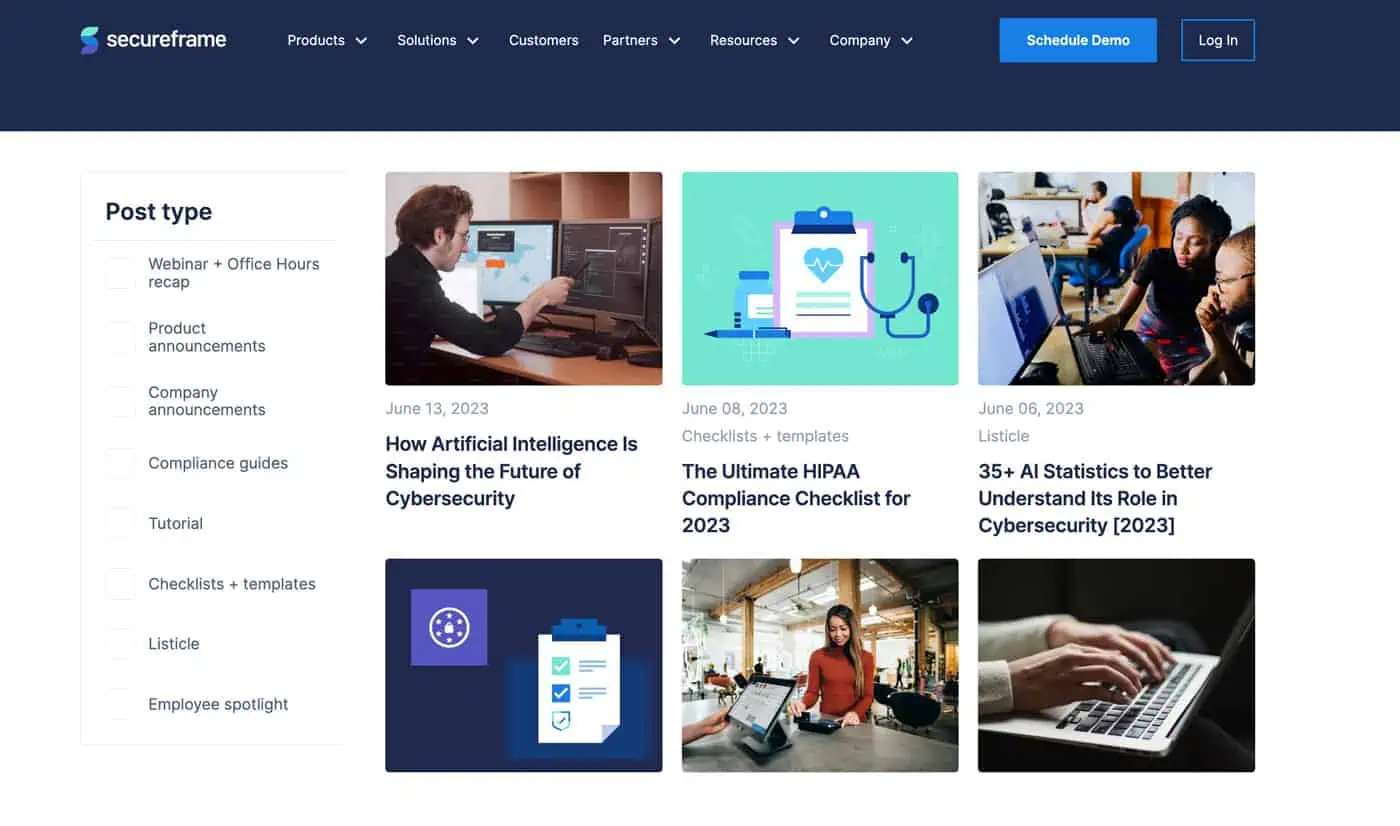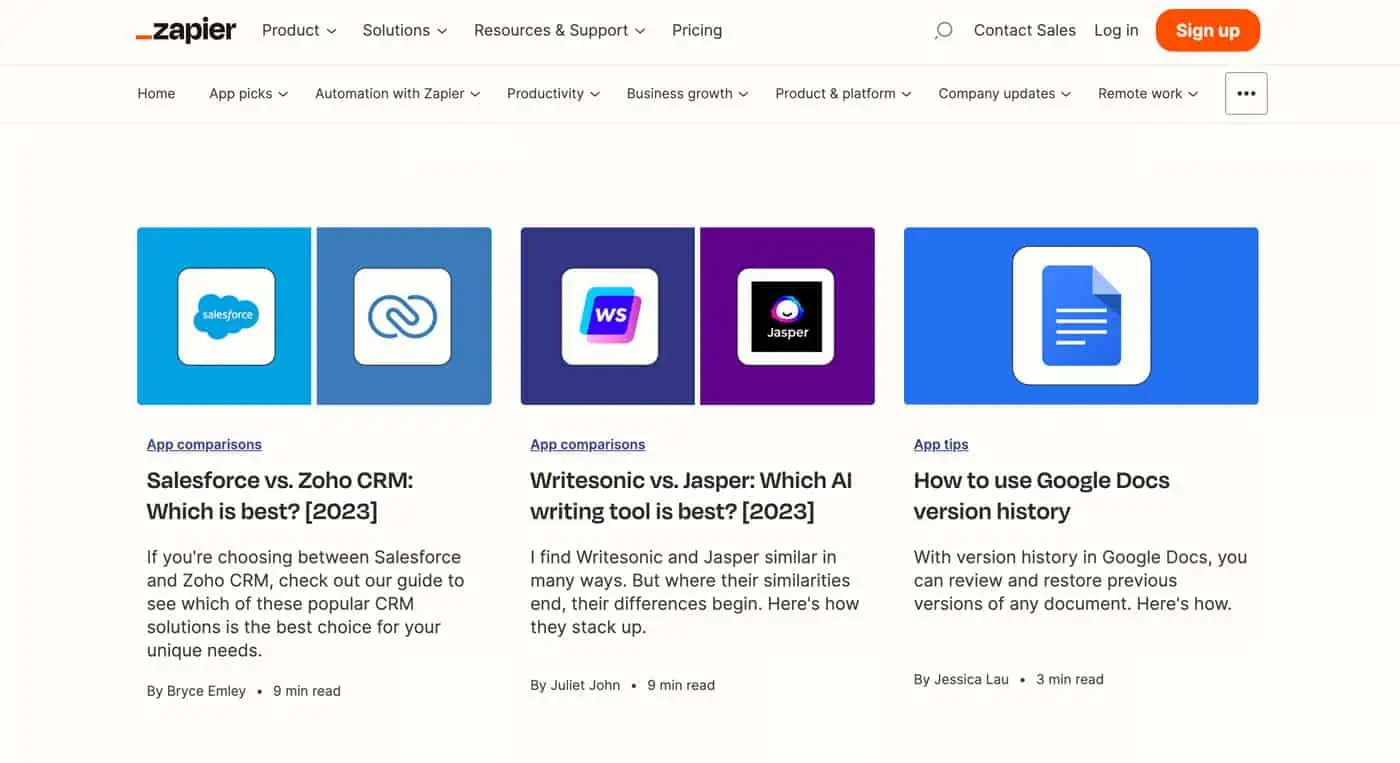B2B businesses devote an average of 33% of their marketing budget to content marketing, so you better have a powerful strategy if you want a strong ROI.
Your marketing team has an exciting idea for a piece of content. For the next month, everyone is hyper-focused on executing it and getting out into the world. But then, a new initiative pops up and diverts marketers’ attention elsewhere. Or a global crisis, like a pandemic, impacts the economic outlook, forcing marketers to pivot their strategies. Before you know it, that great content idea is gathering dust.
Sound familiar? For many B2B businesses, content marketing is an afterthought. After all, anyone can do content creation, right?
Wrong.
If you want to successfully increase your brand awareness, drive more leads, and skyrocket sales in 2023, you need a B2B content marketing strategy that brings results. But navigating the ins and outs of content strategy can be complicated, especially if you have a small team or are just starting out.
At Siege, we do this every day for more than 20 B2B businesses, mainly in the Fintech and SaaS industries. We’ve compiled everything we know about how to create a B2B content marketing strategy that converts so you can increase your traffic and pull in leads.
- What Is B2B Content Marketing?
- Why You Need a B2B Content Marketing Strategy
- 10 Steps To Build a Winning B2B Content Marketing Strategy
- Successful B2B Content Marketing Strategies
What Is B2B Content Marketing?
Content marketing involves creating content (such as blogs, videos, podcasts, etc.) to build brand awareness, create trust, and support your clients’ customers.
In B2B content marketing, the content’s target audience is directed to other businesses that can use your product or service to be more successful. The products or services being marketed are often expensive, and more than one decision-maker is involved in the purchase decision. As a result, the B2B sales cycle is longer (generally 2.1 months) — no impulse buying here.
Your main goal with B2B content is to establish yourself as a trusted authority in the market and support your customers in their efforts to grow their business.
B2B content marketing differs from B2C content marketing you see on social media. In B2C content marketing, the customer makes decisions for themselves.
They respond to emotional content because, in most cases, the product is affordable and the sales process is short — if not instantaneous. So the same strategies B2C content marketers use won’t work for B2B marketers.
You wouldn’t create an ad or other traditional marketing asset willy-nilly, and you shouldn’t create content that way either. Content can be expensive and time-consuming to create, so to ensure you see a positive ROI, you’ll need a clear, precise, and targeted content marketing strategy.
The Necessity of B2B Content Marketing Strategy
A B2B content marketing strategy outlines every step of your process, from planning and ideation to creation, publication, and evaluation. It ensures you release the right content at the right time to the right audience to achieve your goals.
Data proves the time it takes to develop a B2B content marketing strategy is worth it:
B2B buyers want start the buyer’s journey independently:
- 40% of B2B decision-makers consult at least three pieces of content before contacting a sales representative for details about their offerings. (Siege Media)
- B2B buyers often spend most of the buyer’s journey independently, with most reporting they are 57%-70% through the research process before they contact a sales representative for more specific information. (WB Research)
Content marketing is effective:
- Content marketing generates three times more leads than traditional marketing while costing 62% less. (Demand Metric)
- After viewing a vendor’s content, 52% of B2B buyers are “definitely” more inclined to make a purchase. (Siege Media)
B2B buyers value trust when making purchasing decisions:
- The majority (80%) of B2B decision-makers prefer learning about a potential vendor through content like articles rather than a traditional ad. (Siege Media)
- Businesses want to know their vendors understand their goals, with 84% more likely to purchase from a vendor that exhibits knowledge of their objectives. (Salesforce)
Without a clearly defined content marketing strategy, you risk content creation becoming something your marketing team only does when it has time. You may have a few successful pieces of content from pure luck, but you won’t be able to develop the sense of trust needed to turn content consumers into buyers.
10 Steps To Build a Winning B2B Content Marketing Strategy
Fortunately, creating a B2B content marketing strategy isn’t an impossible task. With the right tools, you can create a winning strategy regardless of your company’s offerings or size. The process becomes more complicated the more buyer personas and products you have, but the basic process is the same.
Step 1: Learn More About Your Audience
In content marketing, your audience determines your content, so don’t skip this step. The more you know about your audience, the more meaningful — and successful — your content will be.
To learn as much as you can about your audience, do the following:
Establish buyer personas.
Craft three to five business personas, each of which should include the following information:
- Demographics
- Industry
- Job role
- Goals
- Challenges
- Factors that impact decision making
- Buying behavior
Identify their pain points, buying process, use cases, and common feedback to see what types of content your audience finds helpful.
Map the buyer’s journey to understand what content they’re looking for.
Once you understand each persona, think about how they move from content consumer to buyer by mapping out their journey. Most buyers go through three stages:
- Awareness: Buyers in this stage have a problem and want to learn more about it.
- Consideration: Buyers in this stage understand the problem and look for strategies to solve it.
- Decision: Buyers in this stage explored possible solutions and are ready to make a purchase.
Once you start brainstorming content, you’ll want to ensure you have content for each stage of the buyer’s journey to guide your users through the funnel.
Segment your audience to dig deeper.
Break your audience into segments based on their buyer behavior, preferences, types of problems, or other factors you’re aware of. Then, decide which segments you’ll focus your content efforts on to create highly targeted content.
Step 2: Know Your Product
This one seems like a no-brainer, but it’s especially important if you partner with an agency to craft and execute your content marketing strategy.
Ensure everyone on the team understands exactly what service(s) or product(s) you offer and how they work. Share product demos with your content marketers or grant them access to a free trial so they can see the product in action.
This will help content creators highlight specific ways your product solves clients’ problems, making your content more meaningful.
Create use cases and value propositions for each product or service and update them annually. It’s not unusual for businesses to find clients using their goods and services in unexpected ways, which can open up new audiences for your content.
Step 3: Establish or Refine Your Brand Voice
Before you start creating, establish your brand’s voice and keep your audience’s preferences top of mind. They may not appreciate tongue-in-cheek jokes — no matter how brilliant or well executed — when researching a problem that threatens their bottom line.
Here’s how voice and tone differ:
- Brand voice refers to the adjectives you want your customers to use to describe you as a brand. In short, it’s how your brand expresses itself. These are broad terms, and whatever voice you establish should appear in every piece of content.
- Brand tone refers to how you sound in each piece of content, which can change depending on the buyer persona you target, the type of content you create, or the message you want to convey.
Whatever you decide, write it down in one place and share that document with your entire marketing team to keep things consistent.
Step 4: Identify Your KPIs
Now that you know your audience, your product, and identify your brand voice, establish what you want to accomplish with your content before you move any further.
Your goals must be realistic and clear to guide your decision-making in the next steps. They also need to be measurable so you can gauge your strategy’s success and make informed adjustments in the future.
Use the SMART goal framework:
- Specific: What exactly do you want to happen? Who will do it? How?
- Measurable: What data will indicate success?
- Achievable: Do you have the means to reach this goal?
- Relevant: Why is the goal important?
- Time-bound: What’s the timeline for implementation and completion?
Common KPIs for B2B content marketing include:
- Traffic
- Organic traffic
- Page views
- Leads
- Rankings
- Conversions
- Brand awareness
- Audience engagement
Once you’ve determined what you want to achieve, write it down! You’ll refer to these goals as you ideate content, assemble a content calendar, and evaluate your progress.
Step 5: Prioritize Your Content Types
You’re almost ready to start brainstorming content ideas, but you need to decide what types of content you want to focus your strategy on.
Consider the following:
What you have the bandwidth to create.
- Blog posts take less time to create than eBooks, and some types of content require specialized knowledge — like video editing or website development skills you may not have on your team.
In the beginning stages, focus on content you already have the bandwidth for. As you see success, you can add resources that allow you to go after more complicated content types.
What your audience needs. Depending on their stage in the buyer’s journey, your audience will need different types of content:
- In the awareness stage, users are looking for educational content, like blog posts, guides, and infographics, to learn more about a problem they are experiencing.
- In the consideration stage, users want solution-focused content like tools (templates, calculators, etc.) and technical information, such as webinars and product features, so they can start solving their problems.
- In the decision stage, users seek information to help finalize their purchase, like case studies, testimonials, and comparison posts that show why your product is the best so they can make a more informed purchase decision.
Whatever types of content you want to focus on, remember that you want a balance of timely and evergreen content.
Timely posts show you are a real company operating in the here and now. For example, if you choose not to post content addressing an economic event — like the pandemic’s impact on your industry — you’ll appear out of touch to potential customers.
However, timely content is only popular for a short time. Once that moment is over, there’s no use for your content, meaning you’ll lose traffic and conversions quickly.
Evergreen content, which focuses on content that is always important for your audience, has staying power that will continue to bring in users for the long haul.
You’ll also want to balance the types of content you offer, since not everyone consumes information in the same way. Don’t go all in on one type of content, like eBooks. Instead, weave in infographics, video, webinars, and tools when you can to ensure you reach the widest possible audience in your buyer persona.
Step 6: Brainstorm Relevant Topics
Now it’s time to brainstorm! But don’t pull out the whiteboard and start shouting out ideas just yet — be systematic about it.
Conduct a Content Audit
Before looking for new ideas, investigate what already exists in your content library with a content audit.
Step 1: Inventory all your content in one place, such as a spreadsheet.
Step 2: Organize your content based on topic, type of content, length, target buyer persona, tone, relevance, freshness, or any other relevant factors.
Step 3: Add success metrics.
Step 4: Analyze the information for patterns:
- What content is working?
- What content isn’t working?
- What content can you update or refresh?
- What content can you repurpose into other types of content?
- What content is missing?
Perform a Competitor Analysis
Now that you’ve looked within, it’s time to see what your competitors are doing. Dig through their content libraries and look:
- The type of content they’re creating
- The keywords they’re targeting
- What content is most successful
- What content misses the mark
- How you can stand out from them
Use your competitors’ content library as inspiration but don’t rely on it for long-term success. If you consistently only create content based on what your competitor does, you’ll always be behind on your industry’s trends — costing you in the long run.
Looking for the keywords that will offer the best ROI?
Use Siege Media’s Keyword Opposition to Benefit Analysis post, which explains how to read traffic value and keyword difficulty to your advantage.
Do Keyword Research
There’s no one right way to conduct keyword research. You just need to start from a place of understanding your audience.
With everything you’ve learned about your audience in mind:
- Use keyword research tools like Ahrefs or Moz to find relevant keywords.
- Look for long-tail keywords and topic clusters related to relevant keywords to find low-hanging fruit.
- Set up Google Alerts for your company and product to see what your clients say about you. What keywords can address those conversations?
- Hang out on the same social media channels as your audience — what are they talking about that you can address with your content?
- See what’s trending using tools like Google Trends and Pinterest.
Compile all the relevant keywords from your content audit, competitor analysis, and keyword research in one document.
Step 7: Prioritize Content with the Highest ROI
Now you have all the keywords you brainstormed in one place, but you need to strategize what order in which you’ll create content. It might be tempting to tackle all the high search volume terms first if increasing traffic is your goal, but since that strategy doesn’t consider other factors like keyword difficulty, it probably won’t help you meet your goals.
A successful B2B content management strategy prioritizes keywords with the highest ROI, meaning you need to consider your best chances of ranking while working toward your KPIs.
Don’t waste money on content that won’t bring results.
Use Siege Media’s Content Marketing ROI Calculator to measure your strategy’s projected ROI.
Keep your audience in mind.
Remember all that audience research you did in Step 1? It’s time to put that to work.
Identify the keywords that will resonate most with your audiences and prioritize them. More than any other metric, using what your audience wants and needs to guide your keyword selection will lead you to success.
Prioritize keywords with difficulties appropriate for your Domain Rating (DR).
This doesn’t matter so much if you have a high DR (above 70), but if your DR is below 50 you’ll want to prioritize lower difficulty keywords to see rankings.
Use long-tail keywords to help you find the keyword with the lowest difficulty and the highest search value. You’ll be more likely to rank and increase traffic. And, as you establish a deeper authority in the space, you’ll scale up to keywords with higher difficulty and traffic volume.
Focus on keywords that you have the resources to create.
Some keywords may require a specific type of content. For example, a keyword that includes the word “calculator” is going to require some front-end development to create in order to be successful.
Don’t start out with content that requires all the bells and whistles — start your strategy with content you can easily create to get traffic rolling in, then devote more resources to the content that requires more time and specialized skills to execute.
Ensure the content you create is something your CMS can host.
Keywords that require downloadables (like templates and tools like calculators) make excellent middle-funnel content and deliver a lot of value for your users — but only if they can see them. Your CMS may not be able to host them, which makes the time and effort you’ll put into creating them a waste of resources.
Determine your CMSs capability before you start creating content for these types of keywords so you don’t waste time and money developing something you ultimately can’t post.
You don’t want your gut making these decisions — use data to help you.
A keyword opposition to benefit (KOB) analysis is a powerful tool that assigns each keyword a score based on its traffic value and opportunity in relation to its difficulty. The higher the KOB score, the better chance of success.
Once you determine which keywords to target, create a content calendar. You can do this on a monthly, quarterly, or yearly basis.
When scheduling content, consider seasonality and time to rank. For example, if your keyword relates to paying business taxes, you’ll want to post it a few months before tax season starts so your content will be on the SERP when users actually search for it.
Use a project management tool to assign content creation to your team, monitor progress, and ensure content stays on schedule.
Step 8: Keep SEO Best Practices in Mind
Use SEO best practices as a guide when creating content. You can see a complete list here, but here are a few must-dos to create successful content:
- Craft a clickable title (but don’t veer into click-bait territory).
- Use a simple content structure (but don’t prioritize simplicity over audience needs).
- Be informative, helpful, and compassionate in your delivery (but match it to the overall message).
- Entertain your reader with engaging content (but don’t let the creativity get in the way of the message).
- Keep it short (but don’t sacrifice substance).
Step 9: Distribute and Promote Content
Once your content has been drafted, revised, and polished, you can finally share it with the world.
Use website SEO to guarantee Google sees and returns your content in search results. If your website isn’t returned in search results, no one will see your content — no matter how great it is.
Here are some of the most important steps to take:
- Have a clear site structure and updated sitemap to communicate to Google how content relates.
- Use meta descriptions so Google understands what posts are about.
- Add alt text to images so Google understands how they relate to the post (and get returned in visual search results).
- Optimize loading speed and other Google Core Web Vitals factors.
- Create an internal linking web that ties content together and directs traffic between posts.
Take your content marketing strategy to the next level through link building.
Check out Siege Media’s Link Building Strategies post to help you link build like a pro.
Share your content across multiple channels for maximum visibility.
Use the social media channels where your audience hangs out — for most B2B clients, this includes LinkedIn and Twitter.
Link to your content and engage with your audience so they share it. You may be able to kick-start some powerful dialogue, network with others in your field, and showcase your authority while expanding your audience — all while advertising your content in a refreshingly non-salesy way.
Use paid ads on Google and LinkedIn for high-priority keywords.
Jump start traffic to your content with targeted ads for high-priority keywords.
Let’s say you created a template for a meeting agenda. Take out a Google ad for the keyword “meeting agenda template,” and Google will return your page above their search results, increasing the likelihood a user will click on it.
These ads are often pay-per-click, meaning your company won’t pay for them unless a user clicks on them. Once the post ranks on its own, you can stop running the ad.
Collaborate with others in your field to expand your reach.
Share your resources with other thought leaders. Ask them to add a link to your content in one of their blog posts, write a guest post for their blog, or be a guest on their podcast. Then, reciprocate the favor. In doing so, you’ll broaden your pool of potential customers.
Step 10: Measure Content Performance
Once your content gets out in the world, give it time to do its thing. After a month or so, start measuring its performance against your KPIs, but don’t be surprised if you don’t see any meaningful results immediately — it can take up to nine months to see a meaningful return on your content marketing investment.
Use tools like Google Analytics, Ahrefs, and others to find data relevant to your KPIs on a monthly or quarterly basis. Compare this data over time and look for patterns. Once you see what parts of your content strategy are working and what aren’t, pivot accordingly. Keep doing what brings results and find ways to improve what isn’t, or scrap it altogether.
Successful B2B Content Marketing Strategies
So what does a successful B2B content marketing strategy look like? Here are a few real-world examples.
QuickBooks
QuickBooks markets bookkeeping, payroll, time tracking, and other fintech software to businesses.
Their content marketing strategy prioritizes tools that help users get jobs done, making their blog a one-stop shop for financial resources. While some competitors in their industry gate their tools, QuickBooks utilizes a freemium content strategy, giving away some functionality in the hopes that users eventually convert to paying customers. Other content types in their strategy include how-to guides, templates, and eBooks.
Embroker
Embroker sells commercial insurance so businesses can protect themselves. Their unique selling point in a crowded industry dominated by established players is their digitally-native focus, using AI to tackle issues that create bottlenecks and increase costs for other commercial insurance companies. As a result, their clients get better insurance for less.
Like most types of insurance, people don’t know much about commercial insurance until they need it, like when they’re on the receiving end of a lawsuit or during an accident.
Their blog strategy focuses on educating business owners, prioritizing top-funnel keywords. Creating high-quality content around those keywords led to more than 3,129 organic links and a $185,000 increase in monthly traffic value.
By focusing their content marketing strategy on educational content, they built their topic authority and gained a foothold in an established market.
Secureframe
Secureframe is a B2B SaaS provider that focuses on data security compliance at scale. The industry is highly specialized, with new laws and regulations being enacted constantly. Businesses with a presence in multiple countries also have to navigate different laws in different countries. Secureframe makes that possible.
Initially, Secureframe’s blog lacked a clear strategy, but they knew the competitive nature of the industry would require a more targeted strategy if they wanted to continue to grow.
Their content marketing strategy focused on educating users on the ever-changing, highly technical landscape of data security and passive link intent. They prioritized middle-funnel content such as templates, worksheets, and checklists to help users solve problems.
They also focused on creating top-funnel content such as stats and infographics to educate users about trends in the industry. Their strategy worked, leading to a 560% increase in blog traffic and a 95% increase in backlinks in just six months.
Zapier
Zapier’s bread and butter is workflow automation with a strong focus on integrating web applications across platforms to make work easier for businesses. While they’ve been in the content game as an established player for some time, they wanted to set themselves apart from the competition while leveraging areas of opportunity for growth.
Since they already had a healthy content library, a key component of Zapier’s content strategy was revamping the older content living on their site to ensure its relevance.
They also went after low-difficulty/high-traffic value keywords that aligned with specific buyer personas they weren’t previously targeting, creating tools that helped users solve problems.
Within one year, organic traffic skyrocketed by 1.1 million users with an increased traffic value of $2.1 million.
Build Your B2B Content Marketing Strategy With Siege
If you’re feeling overwhelmed, remember the most crucial part of B2B content marketing: your audience. As long as you make decisions with them in mind, you’re on the path to success.
And if you still aren’t sure you can execute an effective strategy, consider partnering with Siege Media. Our content creation services help our clients bring in more than $148,000,000 of traffic value every year. Let’s talk about how we can work together.


